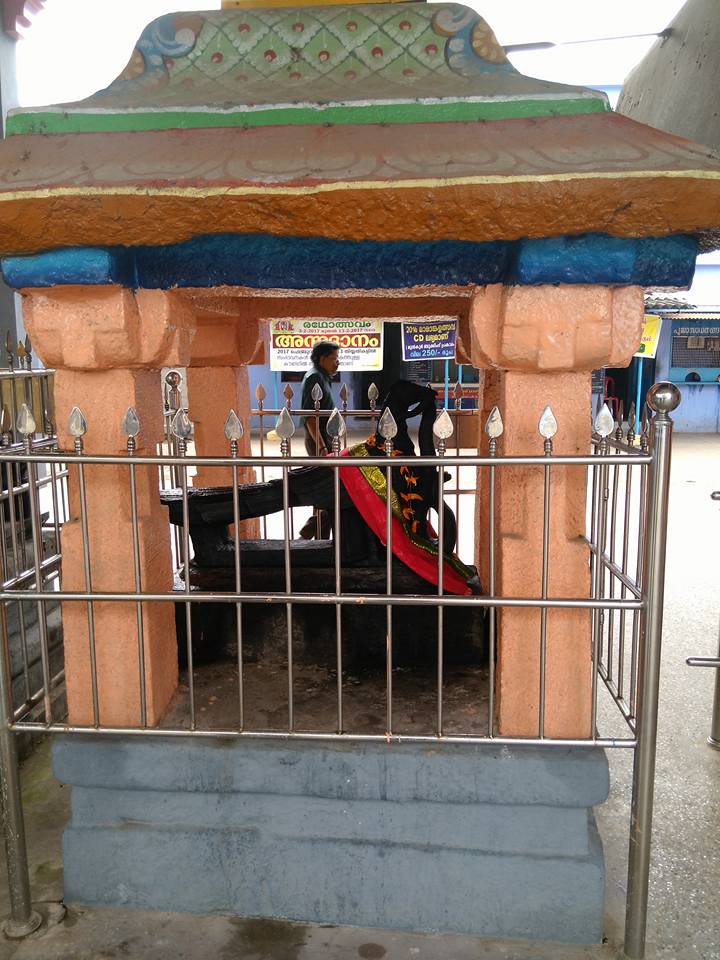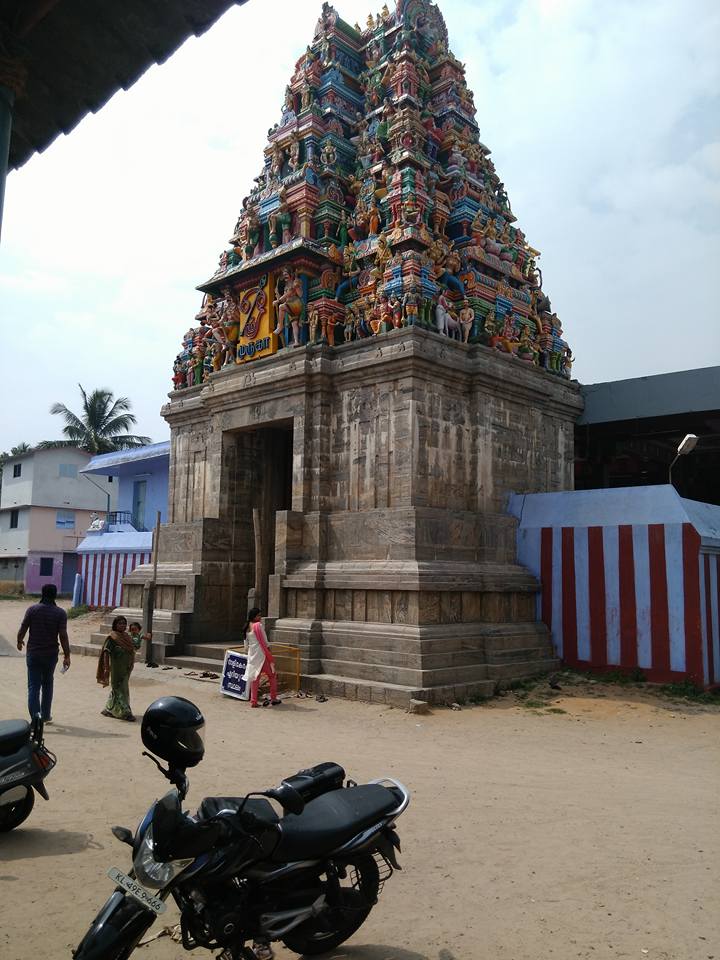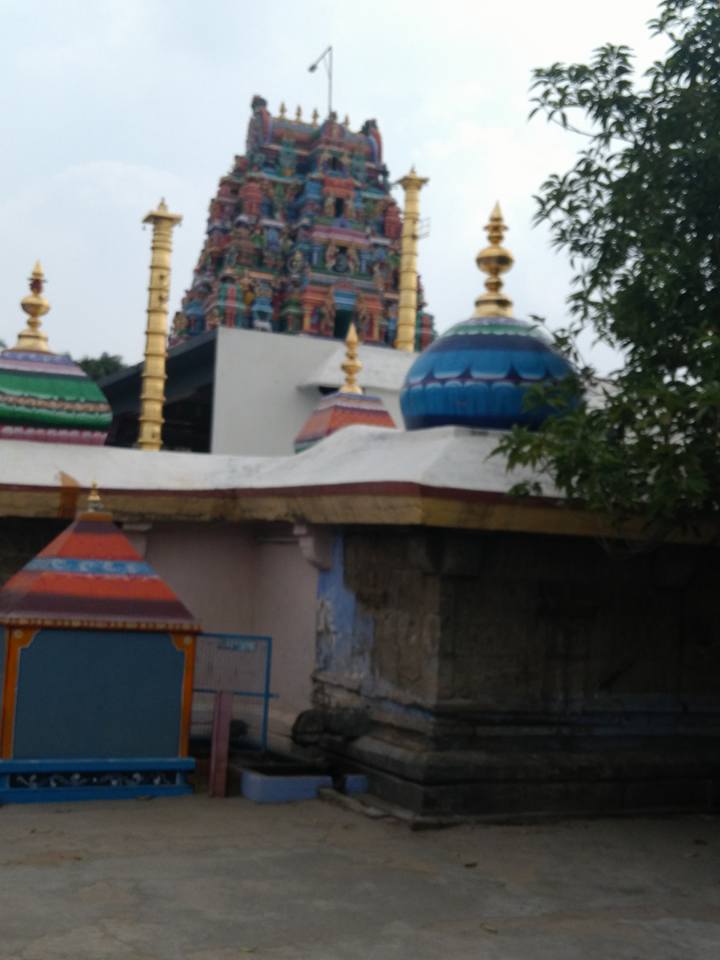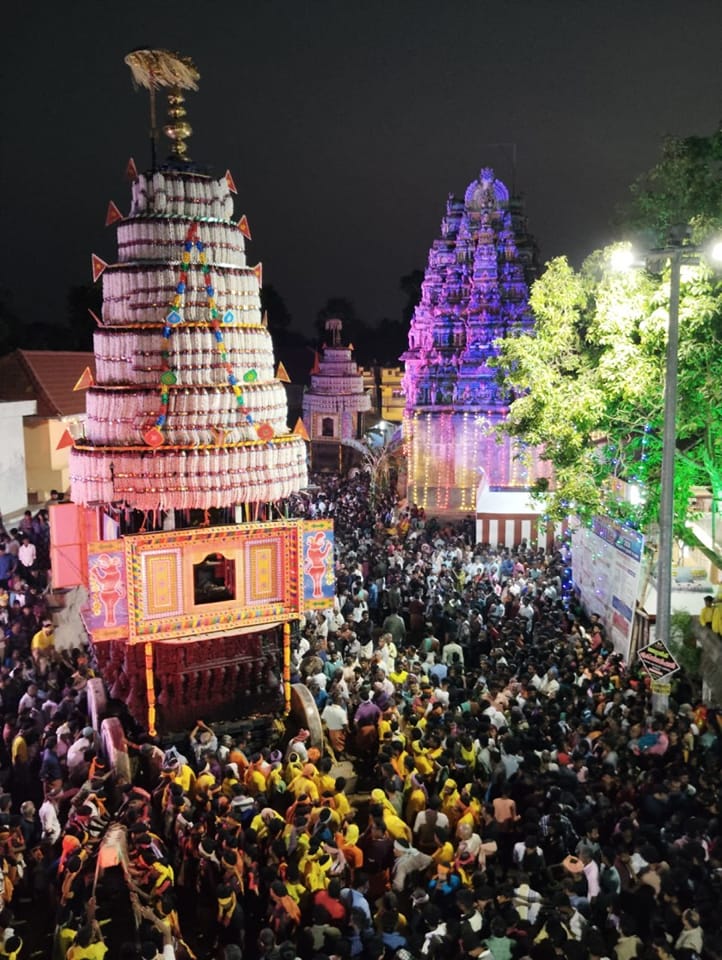Kodumbu Subramaniya Swamy Temple is one of the oldest Murugan temples in the Kerala region. It is located in Kodumba village, in Palakkad district, about 10 kilometers (6.2 miles) southeast of Palakkad and southwest of Coimbatore, nestled in the valley of the Soka Nasini River.

The temple is revered as being half of Palani Murugan, and devotees believe that bathing in the sacred Soka Nasini River will wash away all their sorrows. During the Vijayanagara period, heavy taxes were imposed on Tamil weavers, prompting several families from the Sengunthar Kaikola Mudaliyar community to migrate from Kanchipuram to Kodumbu, near Palakkad.
There, they established a thriving weaving industry. They would transport their woven goods in bullock carts to Avinashi town near Coimbatore, sell their textiles, and then return to Kodumbu to purchase the materials needed for weaving.
On one such return journey from Avinashi, they suddenly heard a mysterious voice calling out, "I am coming, I am coming." Curious, the Sengunthars stopped and looked around but found no one. As they attempted to move on, the bullock cart refused to budge.
Despite their efforts, the cart remained still. Again, the voice echoed, "I am coming, I am coming." Following the sound, they discovered a brightly shining stone among the bushes. Amazed by its glow, they carefully placed the stone among their bundles. Instantly, the bullock cart began to move forward. Upon returning to Kodumbu, the community enshrined the sacred stone in the local Shiva temple and began worshipping it as Subramanya Swamy, establishing it as the Kuladevata (family deity) of the Senguntha Kaikolar community.
After some years, Arundhan Namboodiri, a priest from the Kurur family who conducted pujas at the Shiva temple, expressed his desire to perform the rituals for Subramanya Swamy as well. However, the Senguntha Kaikolar community opposed this, insisting that the worship of their deity, who originated from Tamil Nadu, should follow Tamil-style rituals. Namboodiri disagreed and escalated the matter to the King of Palakkad.
The King of Palakkad intervened to settle the dispute.
He decreed that since both sides could not agree, a trial would be held each faction was to place a sacred kumbha (pot) at the northern entrance of the temple. King ruled that whichever side's kumbha prevailed would be given the right to perform the worship of Lord Subramanya.
The Senguntha Kaikolar community brought a lineage record of Manikkavasagar from Madurai, sang Tamil hymns, and placed their kumbha.
On the other hand, the Namboodiri used some mystical practices to place his kumbha. However, the Namboodiri’s efforts were unsuccessful, while the genealogy of Manikkavasagar prevailed, demonstrating divine favor. Witnessing this, the King ordered that the worship of Subramanya Swamy should henceforth be conducted in the Tamil tradition.
Accepting his defeat gracefully, the Namboodiri donated a portion of his land to the Subramanya Swamy Temple. In recognition of his contribution, a tradition was established where the Kurur family representatives would offer Thirumajana Kalam (a special ceremonial bath) to the deity four times a year — on the day of Subramanya Swamy’s establishment and during the Navratri festival.
The tower, chariots, and halls of the Kodumbu Subramaniya Swamy Temple are built in classic Dravidian architectural style. In the sanctum sanctorum, Lord Subramanya Swamy is enshrined along with his two consorts, Valli and Deivanai, depicted as a single unified sculpture. The temple complex also houses shrines for Lord Shiva, Goddess Umadevi, Lord Parasurama, Lord Krishna, Lord Shasta, and Lord Bhairava. Statues of the Senguntha Navaveerargal and Veerabahu — the heroic ancestors of the Senguntha Kaikolar community — are also present. The temple’s sacred flower is the Cenotaph tree (Vanni maram).
Special rituals are performed on all auspicious days related to Lord Muruga. The temple celebrates Thaipooyam with a grand ten-day festival beginning on the day of the Parani star in the Tamil month of Thai. Another major event is the Sura Samhaaram during Kandasashti in the Tamil month of Aippasi, where the defeat of the demon Suran is ritually reenacted. During this celebration, members of the Senguntha Kaikolar community, dressed as Murugan's lieutenants — the Navaveerargal — enact the battle against Suran.
The temple also observes festivals like Sashti, Krittika days, Karthigai Deepam, Panguni Uthram, and the Chariot Festival with great devotion and splendor.
Devotees hold a strong belief that praying to Lord Murugan here can resolve marital disputes and restore harmony in family life. The river flowing near the temple, known as the "Tragedy River" (Soka Nasini), is believed to wash away the sorrows of devotees who bathe in its waters.
Mahamaghat Festival is celebrated once every twelve years on this river, coinciding with the Mahamaga festival held at Kumbakonam.
The temple is open daily from 5:30 AM to 12:00 PM and again from 4:30 PM to 8:00 PM. Notably, the temple’s Raja Gopuram (main tower) is the second tallest among all temples in Kerala.
കൊടുമ്പ് സുബ്രഹ്മണ്യസ്വാമി ക്ഷേത്രം
കേരളത്തിലെ പാലക്കാട് ജില്ലയിലെ കൊടുമ്പ് ഗ്രാമത്തിൽ സ്ഥിതിചെയ്യുന്ന ഒരു പ്രശസ്ത ക്ഷേത്രമാണ് കൊടുമ്പ് സുബ്രഹ്മണ്യസ്വാമി ക്ഷേത്രം.കല്യാണസുബ്രഹ്മണ്യസ്വാമി ക്ഷേത്രം എന്ന പേരിലും ഈ ക്ഷേത്രം അറിയപ്പെടുന്നു.പാലക്കാട് നഗരത്തിൽ നിന്ന് ഏകദേശം 10 കിലോമീറ്റർ തെക്കുകിഴക്കായി, കോയമ്പത്തൂരിന്റെ തെക്കുപടിഞ്ഞാറായി, ശോകനാശിനി നദിയുടെ മനോഹരമായ താഴ്വരയിലാണ് ഈ ക്ഷേത്രം സ്ഥിതിചെയ്യുന്നത്. കൊടുമ്പ് ക്ഷേത്രത്തെ പഴനി മുരുകന്റെ പകുതിയായി ഭക്തജനങ്ങൾ വിശ്വസിക്കുന്നു.
വിജയനഗര ഭരണകാലത്ത് തമിഴ് നെയ്ത്തുകാരുടെ മേൽ കനത്ത നികുതി ചുമത്തിയതിനെത്തുടർന്ന്, സെങ്കുന്തർ കൈക്കോല മുതലയാരുകളുടെ ചില കുടുംബാംഗങ്ങൾ കാഞ്ചീപുരത്തിൽ നിന്ന് പാലക്കാടിനടുത്തുള്ള കൊടുമ്പിലേക്ക് കുടിയേറി നെയ്ത്ത് വ്യവസായം ആരംഭിച്ചു. അവർ തുണിത്തരങ്ങൾ കാളവണ്ടിയിൽ കയറ്റി കോയമ്പത്തൂരിനടുത്തുള്ള അവിനാശി പട്ടണത്തിൽ എത്തിച്ച് വിൽപ്പന നടത്തി, അവിടെ നിന്ന് നെയ്ത്തിന് ആവശ്യമായ സാധനങ്ങൾ വാങ്ങി കൊടുമ്പിലേക്ക് മടങ്ങാറായിരുന്നു.
ഒരു ദിവസം അവിനാശിയിൽ നിന്ന് തിരിച്ചുവരുമ്പോൾ, "ഞാൻ വരുന്നു, വരുന്നു" എന്നൊരു ശബ്ദം അവർ കേട്ടു. സെങ്കുന്തർ വണ്ടി തടഞ്ഞുനിർത്തി, ചുറ്റും തിരഞ്ഞെങ്കിലും ആരെയും കണ്ടില്ല. പിന്നീട് അവർ വീണ്ടും യാത്ര തുടരണായി ശ്രമിച്ചെങ്കിലും കാളവണ്ടി നീങ്ങാൻ വിസമ്മതിച്ചു. അതേസമയം വീണ്ടും ആ ശബ്ദം കേട്ടു. ശബ്ദത്തിന്റെ ദിശയിലേക്ക് നോക്കിയപ്പോൾ കുറ്റിക്കാട്ടിൽ നിന്ന് ഒരു കല്ല് തിളങ്ങുന്നത് അവർ കണ്ടു.
അതിന്റെ പ്രകാശത്തിൽ അദ്ഭുതപ്പെട്ട അവർ കല്ല് എടുത്ത് തങ്ങളുടെ കെട്ടുകളിൽ ഒറ്റവണ്ണം സൂക്ഷിച്ചു. ഉടൻ കാളവണ്ടി മുന്നോട്ട് നീങ്ങിത്തുടങ്ങി.
കൊടുമ്പിൽ തിരിച്ചെത്തിയ ശേഷം, സെങ്കുന്തർ ശിവക്ഷേത്രത്തിൽ ഒരു പ്രത്യേക ശ്രീകോവിൽ പണിതു, ആ കല്ല് അവിടെ സ്ഥാപിച്ച്, കുലദേവതയായ സുബ്രഹ്മണ്യസ്വാമിയെ ആരാധിക്കാൻ തുടങ്ങി. വർഷങ്ങൾക്കുശേഷം, ശിവപെരുമാൾ ക്ഷേത്രത്തിൽ പൂജകൾ നടത്തിയിരുന്ന കുറൂർ ദേശക്കാരനായ അരുന്ധൻ നമ്പൂതിരി, സുബ്രഹ്മണ്യസ്വാമിക്ക്เอง പൂജകൾ നടത്താമെന്ന് പ്രസ്താവിച്ചു. എന്നാൽ തമിഴ്നാട്ടിൽ നിന്നുള്ളവർ ആവശ്യപ്പെട്ടിരുന്ന തമിഴ് രീതിയിലുള്ള പൂജ മാത്രമേ വേണ്ടതെന്ന നിലപാടിൽ സെങ്കുന്ത കൈക്കോളർ കുടുംബം നിലകൊണ്ടു. നമ്പൂതിരി ഇതിന് സമ്മതിച്ചില്ല.
തുടർന്ന് നമ്പൂതിരിമാർ പാലക്കാട് രാജാവിനോട് പൂജ നടത്താനനുവദിക്കാൻ അപേക്ഷിച്ചു.
ഇത് പരിഗണിച്ച പാലക്കാട് രാജാവ് നേരിട്ട് സ്ഥലത്തെത്തി ഇരുവശത്തോടും സമാധാനം നടത്താൻ ശ്രമിച്ചു. എന്നാൽ രണ്ട് വിഭാഗങ്ങൾക്കും അനുകൂലമായൊരു കരാറിൽ എത്താനായില്ല. അതിനാൽ രാജാവ്, ക്ഷേത്രത്തിന്റെ വടക്കേ ഗോപുരത്തിൽ ഇരുവിഭാഗവും തങ്ങളുടെ കുംഭം സ്ഥാപിക്കണം എന്നും, പിന്നീട് പാലക്കാട് സിംഹാസനത്തിലെത്തുന്നവർ സുബ്രഹ്മണ്യ മുരുകനെ പതിവായി ആരാധിക്കണം എന്നും ഉത്തരവിട്ടു.
സെങ്കുന്തർ കൈക്കോളരുടെ പക്ഷത്തുനിന്ന് മധുരയിൽ നിന്നുള്ള മാണിക്കവാചകരുടെ വംശാവലിയെ കൊടുമ്പിലേക്ക് കൊണ്ടുവന്നു. അവർ തമിഴ് ഭാഷയിൽ പാടി ഒരു വലിയ ജനക്കൂട്ടത്തെ ഒരുക്കി. അതേസമയം നമ്പൂതിരിമാർ ചില മന്ത്രവാദങ്ങൾ നടത്തി ഒരു ജനക്കൂട്ടത്തെ ഒരുക്കി. എന്നാൽ നമ്പൂതിരിമാർക്ക് ബാലന്റെ കുടുംബത്തെ സ്വന്തമാക്കാനായില്ല. ഒടുവിൽ രാജാവ് തമിഴ് ഭാഷയിൽ പതിവായി ആരാധിക്കാൻ നിർദ്ദേശം നൽകി.
മത്സരത്തിൽ പരാജയപ്പെട്ട നമ്പൂതിരി തന്റെ ഭൂമിയുടെ ഒരു ഭാഗം സുബ്രഹ്മണ്യസ്വാമി ക്ഷേത്രത്തിന് ദാനമായി നൽകി. ഇതിന് പകരമായി, സമുദായത്തിലെ പ്രമുഖരായ മുതലാളിമാർ കുറൂർ ആകിയ അക്ഷദൻ നമ്പൂതിരിയുടെ മന്ദിരത്തിൽ, മുരുകപ്പുര്മന്റെ പ്രതിഷ്ഠാദിനത്തിലും ക്ഷേത്രത്തിലെ നവരാത്രി ആഘോഷങ്ങളിലും വർഷത്തിൽ നാല് തവണ സമർപ്പിക്കേണ്ടതുണ്ടായി.തുലാമാസത്തിൽ (ഒക്ടോബർ-നവംബർ) ആഘോഷിക്കപ്പെടുന്ന വാർഷിക ഉത്സവമാണ് ശൂരസംഹാരം.
ഈ ഉത്സവം അമാവാസി ദിനത്തിൽ ആരംഭിച്ച് സ്കന്ദഷഷ്ഠി ദിനത്തിൽ സമാപിക്കും. സ്കന്ദപുരാണത്തിന്റെ പ്രകാരം, മുരുകൻ തന്റെ ദിവ്യായുധമായ വേൽ ഉപയോഗിച്ച് ശൂരപത്മനെ സംഹരിച്ചതിന്റെ സ്മരണയ്ക്കായാണ് ഈ ഉത്സവം ആഘോഷിക്കുന്നത്. സുബ്രഹ്മണ്യസ്വാമിയും അസുരന്മാരുമായുള്ള ആചാരയുദ്ധത്തിന്റെ ഭക്തിപൂർണമായ രൂപമാണ് ശൂരസംഹാരം.
ആന മഹാശൂരൻ, സിംഗമുകൻ, ബാണുകോപൻ, ശൂരപത്മൻ എന്നിവരുടെ കൂറ്റൻ പ്രതിമകൾ ഭക്തർ വഹിച്ച് പ്രദക്ഷിണം നടത്തുന്നു.
വീരബാഹു, ബാല സുബ്രഹ്മണ്യൻ, കല്യാണ സുബ്രഹ്മണ്യൻ എന്നിവരുടെ വിഗ്രഹങ്ങൾ പ്രത്യേക രഥങ്ങളിൽ എഴുതി കൊണ്ടുപോകുന്നു.
മകരമാസത്തിലെ (ജനുവരി-ഫെബ്രുവരി) ഭരണി നക്ഷത്രത്തിൽ ആരംഭിച്ച് പത്ത് ദിവസം നീളുന്ന ഉത്സവമാണ് തൈപ്പൂയം ഉത്സവം. തൈപ്പൂയ്യത്തിന്റെ ഏഴാം ദിവസം കൊടുമ്പ് ക്ഷേത്രത്തിൽ രഥോത്സവം ഗംഭീരമായി ആഘോഷിക്കുന്നു.



